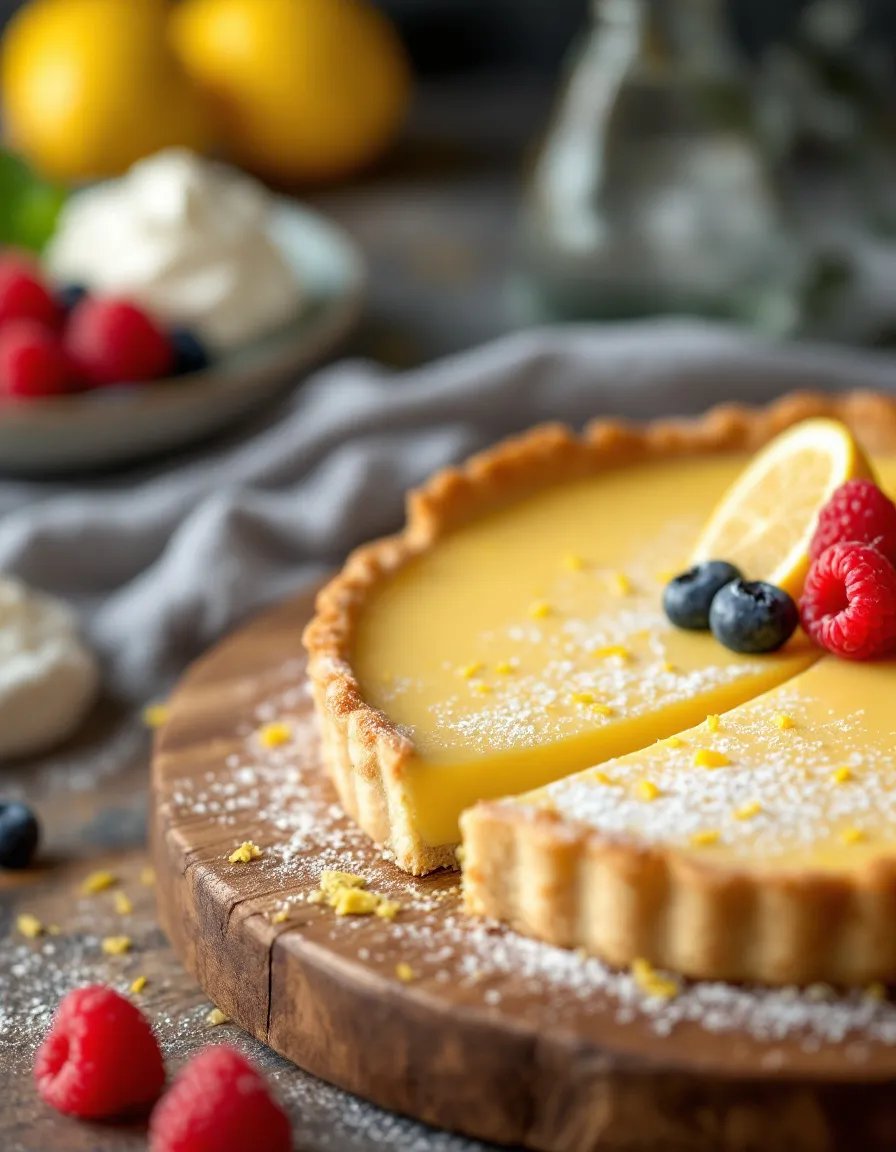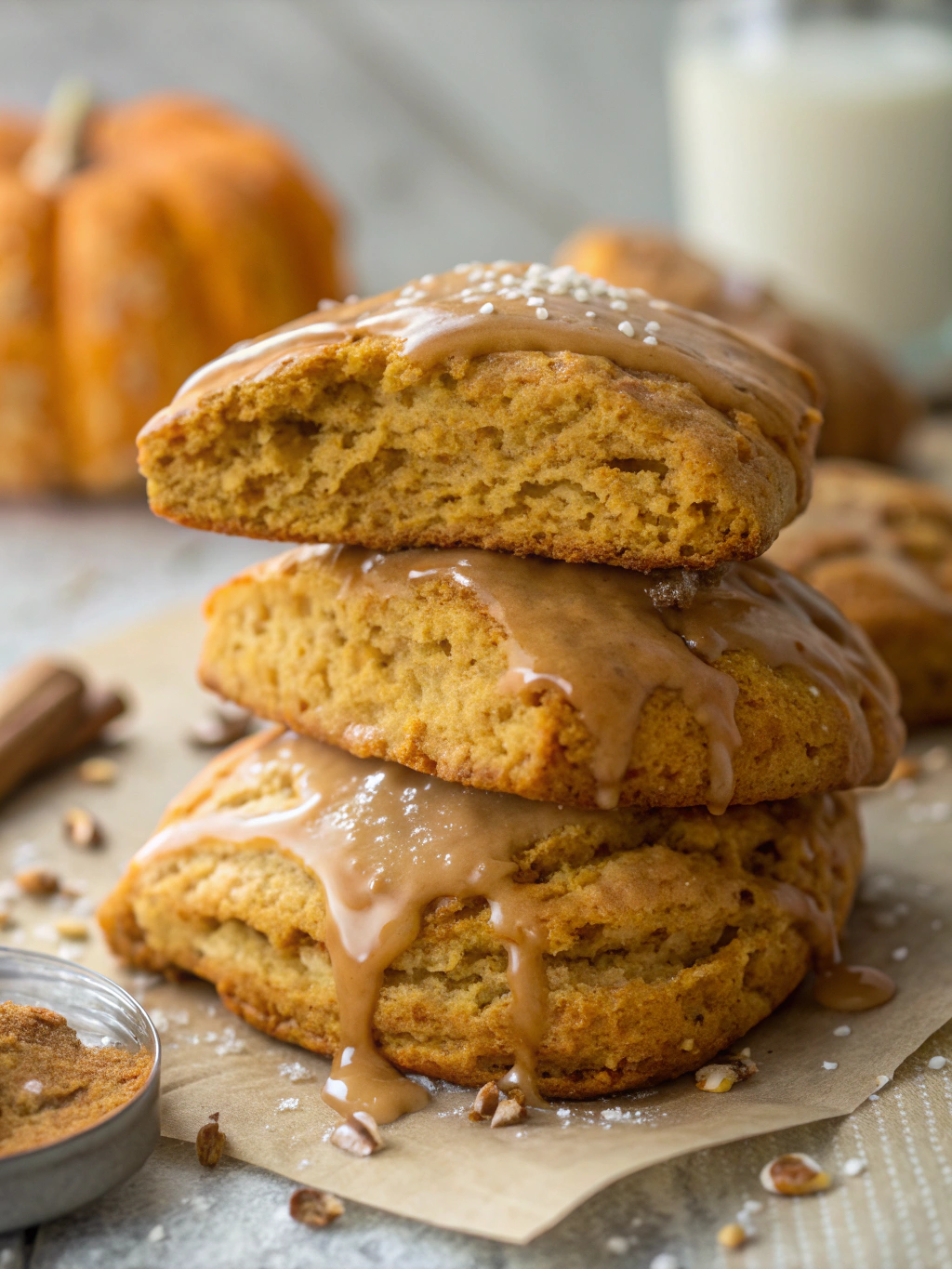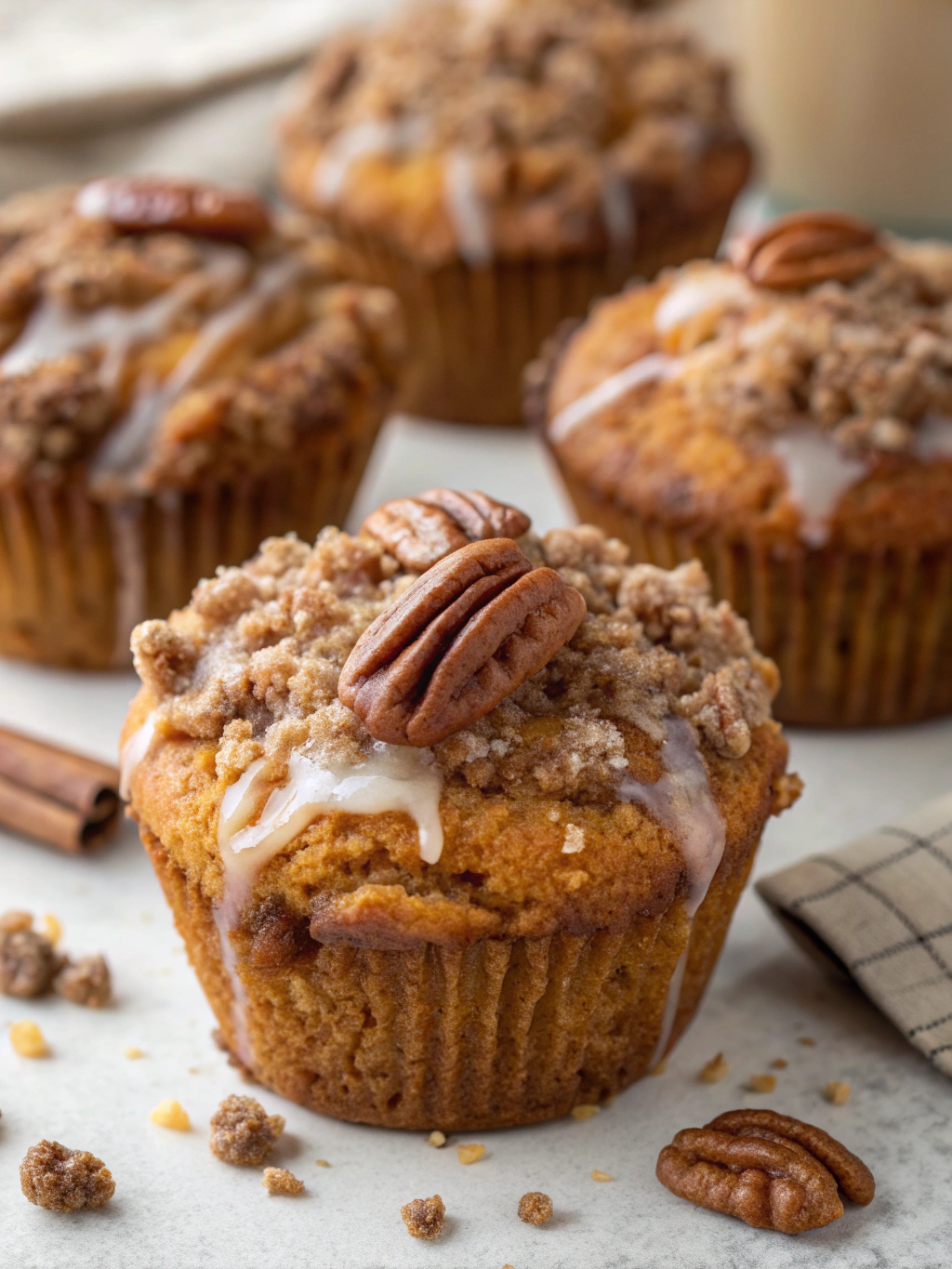Lemon Bliss Tart: A Zesty, Creamy Dessert That Delights the Senses
This Lemon Bliss Tart is a showstopping dessert that combines a buttery, crisp crust with a velvety smooth lemon filling. The bright, citrusy flavor is perfectly balanced with just the right amount of sweetness, making it a refreshing treat for any occasion. Whether you’re hosting a dinner party or simply craving a tangy dessert, this tart delivers a burst of sunshine in every bite.
The magic of this Lemon Bliss Tart lies in its simplicity and elegance. The filling is made with fresh lemon juice and zest, creating an intense citrus flavor that’s both vibrant and sophisticated. Topped with a dusting of powdered sugar or fresh berries, it’s as beautiful as it is delicious. The contrast between the crisp crust and the creamy filling makes each mouthful a delightful experience.
Quick Recipe Highlights
- Flavor Profile: A perfect balance of tangy lemon and sweet creaminess with a hint of vanilla.
- Texture: Buttery, crisp crust paired with a silky smooth lemon filling that melts in your mouth.
- Aroma: Fresh citrus notes with subtle vanilla undertones that fill the kitchen as it bakes.
- Visual Appeal: Gorgeous golden crust with a vibrant yellow filling, perfect for elegant presentation.
- Skill Level Needed: Requires basic baking skills but achievable for home cooks with patience.
- Special Equipment: 9-inch tart pan with removable bottom, fine mesh sieve, and citrus zester.
Recipe Overview
- Difficulty Level: This Lemon Bliss Tart is intermediate level due to the pastry crust preparation and careful baking of the filling. The techniques are straightforward but require attention to detail.
- Category: Perfect for desserts, afternoon tea, or special occasion sweets. Works well for both casual and formal gatherings.
- Cuisine: Inspired by French patisserie traditions with modern home baking adaptations. The tart showcases classic European dessert techniques.
- Cost: Mid-range ingredients with lemons being the star. Uses pantry staples like eggs, butter, and sugar for an affordable luxury.
- Season: Ideal for spring and summer when citrus is at its peak, but delicious year-round thanks to the bright lemon flavor.
- Occasion: Excellent for dinner parties, bridal showers, Mother’s Day, or as a refreshing end to rich meals.
Why You’ll Love This Lemon Bliss Tart
The first thing you’ll notice about this Lemon Bliss Tart is its incredible balance of flavors. The tartness of fresh lemons is perfectly offset by the sweetness of the filling and the richness of the buttery crust. Unlike overly sweet desserts, this tart offers a sophisticated flavor profile that appeals to both citrus lovers and those who prefer milder sweets. The texture contrast between the crisp crust and creamy filling makes each bite exciting.
From a preparation standpoint, this recipe offers several advantages. While it looks impressive, the techniques are accessible to most home bakers. The crust can be made ahead, and the filling comes together quickly with basic ingredients. Unlike fussy desserts that require constant attention, this tart bakes relatively hands-off once assembled. The result looks professionally made but requires no special decorating skills.
Nutritionally, this Lemon Bliss Tart offers some benefits compared to heavier desserts. The lemon provides vitamin C and antioxidants, while the eggs in the filling contribute protein. By controlling the sugar level, you can enjoy a dessert that satisfies your sweet tooth without being overwhelming. The portion size is naturally controlled by slicing the tart, helping with mindful eating.
For entertaining, this tart is a dream. It can be made a day ahead, freeing up your time when hosting. The elegant appearance makes it suitable for any table setting, from casual to formal. Guests always appreciate homemade desserts, and this one stands out from typical cakes or cookies. It pairs beautifully with coffee, tea, or dessert wines, making it versatile for different occasions.
Cost-wise, this Lemon Bliss Tart delivers excellent value. The ingredients are relatively inexpensive, especially when lemons are in season. A single tart serves 8-10 people, making it more economical than individual desserts. The impressive presentation belies its affordable ingredient list, allowing you to serve a gourmet dessert without gourmet prices.
Historical Background and Cultural Significance
The lemon tart has its roots in French patisserie, where it’s known as “tarte au citron.” This classic dessert became popular in the 19th century when citrus fruits became more widely available in Europe. French chefs perfected the balance of sweet and tart, creating what we now consider the gold standard for lemon desserts. The version we know today likely evolved from earlier medieval custard tarts that used whatever fruits were available.
In culinary culture, the lemon tart represents the sophistication of French baking techniques. The perfect tart requires mastery of several skills: making a flaky pâte sablée (sweet shortcrust pastry), preparing a smooth citrus curd, and achieving the ideal bake that sets the filling without overcooking it. Professional pastry chefs often use it as a test of fundamental skills, making it a respected dessert in the culinary world.
Over time, the lemon tart has seen numerous variations across different cultures. In Italy, a similar dessert might include ricotta or mascarpone. British versions sometimes incorporate a meringue topping, creating the lemon meringue pie. American adaptations might use graham cracker crusts for a more casual approach. Despite these variations, the French-style Lemon Bliss Tart remains the most elegant and pure expression of the form.
Today, the lemon tart holds a special place in dessert menus worldwide. Its bright flavor provides a refreshing contrast to rich meals, making it a favorite in restaurants and homes alike. The simplicity of its ingredients allows the quality of each component to shine, embodying the French culinary principle of letting excellent ingredients speak for themselves. This timeless dessert continues to inspire new generations of bakers.
Ingredient Deep Dive
Fresh Lemons: The star of our Lemon Bliss Tart, fresh lemons provide both juice and zest for maximum flavor. Look for lemons with smooth, bright yellow skin that feel heavy for their size, indicating juiciness. Organic lemons are ideal since you’ll be using the zest. Store whole lemons at room temperature for short-term use or in the refrigerator for up to a month. For the best flavor, juice lemons at room temperature and zest before juicing.
Butter: High-quality unsalted butter is essential for both the crust and filling. European-style butter with higher fat content (82-86%) creates the flakiest crust and richest filling. Butter should be cold for the crust but softened for the filling. For dairy-free versions, high-quality plant-based butters can substitute, though the flavor profile will change slightly. Always use unsalted to control the tart’s overall saltiness.
Eggs: Fresh, large eggs provide structure and richness to the filling. The proteins in eggs thicken the lemon mixture when baked, creating the perfect custard texture. For best results, use room temperature eggs as they incorporate more evenly. If concerned about food safety, pasteurized eggs are an excellent option. Vegans can experiment with cornstarch or agar-agar alternatives, though the texture will differ.
Granulated Sugar: White granulated sugar sweetens both the crust and filling. In the crust, it adds tenderness and flavor; in the filling, it balances the lemon’s acidity. For a deeper flavor, you could substitute some with light brown sugar in the crust. Those reducing sugar can decrease the amount slightly, but remember sugar contributes to the filling’s proper set.
All-Purpose Flour: Standard all-purpose flour creates the tart’s sturdy yet tender crust. For a more delicate texture, some bakers substitute a portion with cake flour. Gluten-free blends designed for pastry can work well for those with dietary restrictions. Always measure flour by weight for accuracy or use the spoon-and-level method if measuring by volume.
Common Mistakes to Avoid
- Overworking the dough: This develops gluten, making the crust tough instead of tender. Mix just until the dough comes together, and handle it minimally when rolling.
- Not chilling the dough sufficiently: Skipping or shortening the chill time leads to shrinkage during baking. Always chill for at least 30 minutes.
- Overbaking the filling: The filling should jiggle slightly in the center when removed from oven. It will set further as it cools.
- Using bottled lemon juice: Fresh juice makes a dramatic difference in flavor. Bottled juice often has preservatives that alter the taste.
- Not blind baking the crust properly: Inadequate blind baking results in a soggy bottom. Use pie weights and bake until golden.
- Zesting too deeply: Only remove the yellow zest, avoiding the bitter white pith beneath.
- Adding hot filling to warm crust: Both should be at room temperature to prevent sogginess.
- Not straining the filling: Straining ensures perfectly smooth texture without any cooked egg bits.
Essential Techniques
Blind Baking: This crucial step ensures your tart shell is fully cooked and crisp before adding the wet filling. After lining your pan with dough, chill it, then line with parchment and fill with pie weights or dried beans. Bake until the edges are set, then remove weights and bake until golden. This prevents the crust from puffing up or becoming soggy when the filling is added.
Tempering Eggs: When making the lemon filling, you must gradually warm the eggs by slowly adding hot liquid while whisking constantly. This prevents scrambling. Start by whisking eggs with sugar, then drizzle in the hot lemon mixture a little at a time until combined. Then you can return everything to the heat to thicken properly.
Testing Doneness: The tart is done when the edges are set but the center still jiggles slightly when gently shaken. It will continue to set as it cools. Overbaking causes cracking and a rubbery texture. Watch carefully during the last few minutes of baking, as the transition from perfect to overdone happens quickly.
Pro Tips for Perfect Lemon Bliss Tart
- Roll the dough between parchment paper for easy handling and to prevent sticking.
- Use a microplane zester for the finest lemon zest that distributes evenly.
- Bake the tart on the lower oven rack to ensure the bottom crust cooks thoroughly.
- Let the tart cool completely before slicing to allow the filling to set properly.
- For extra shine, brush the cooled tart with a thin layer of warmed apricot jam.
- Serve slightly chilled for the best texture and flavor balance.
Variations and Adaptations
Berry Swirl: After pouring the lemon filling, drop spoonfuls of raspberry or blueberry puree on top and swirl gently with a knife for a marbled effect. The berries add beautiful color and complementary flavor.
Coconut Crust: Replace half the flour in the crust with finely ground unsweetened coconut for a tropical twist. The coconut’s subtle sweetness pairs wonderfully with the tart lemon.
Mini Tarts: Divide the dough and filling among small tart pans for individual servings. Reduce baking time by about 5-7 minutes for these petite versions.
Lavender Infusion: Steep culinary lavender in the cream for the filling to add floral notes. Strain before adding to the egg mixture for a sophisticated flavor profile.
Serving and Presentation Guide
For elegant presentation, dust the cooled Lemon Bliss Tart with powdered sugar using a fine-mesh sieve. Fresh berries, edible flowers, or mint leaves make beautiful garnishes. A dollop of whipped cream or crème fraîche on each slice adds richness. Serve with a small pitcher of raspberry coulis for guests to drizzle themselves.
Cut the tart with a sharp, thin-bladed knife dipped in hot water and wiped clean between slices for neat portions. A cake server or small offset spatula helps lift slices without breaking the delicate crust. For formal occasions, plate each slice individually with artistic sauce drizzles and garnishes.
Wine and Beverage Pairing
The bright acidity of this Lemon Bliss Tart pairs beautifully with sweet wines like Moscato d’Asti or late-harvest Riesling. For a classic combination, try a glass of chilled limoncello. Non-alcoholic options include sparkling lemonade or hibiscus iced tea. Coffee lovers will enjoy it with a lightly sweetened cappuccino.
For dessert wine pairings, look for bottles with good acidity to match the tart’s citrus notes. Sauternes, ice wines, or even a demi-sec Champagne work wonderfully. Avoid heavy, tannic reds that would clash with the delicate flavors. The wine should be at least as sweet as the dessert to prevent tasting bitter.
Storage and Shelf Life
Store the Lemon Bliss Tart covered in the refrigerator for up to 3 days. The crust will soften slightly over time but remains delicious. For longer storage, freeze individual slices wrapped tightly in plastic then foil for up to 1 month. Thaw overnight in the refrigerator before serving.
To maintain crispness, store with a paper towel underneath to absorb any condensation. Avoid storing near strongly scented foods as the tart can absorb odors. For best texture and flavor, bring to room temperature for about 15 minutes before serving chilled tart.
Make Ahead Strategies
The tart dough can be made up to 3 days in advance and kept refrigerated, or frozen for 1 month. Blind bake the crust up to 24 hours ahead; store at room temperature covered with foil. The lemon filling can be prepared 1 day ahead and refrigerated; gently reheat before pouring into the crust.
For easiest assembly, complete all components separately, then assemble and bake the tart the day of serving. The fully baked tart holds well for several hours at room temperature before serving. Add fresh garnishes just before presenting for optimal appearance.
Scaling Instructions
To make mini tarts, divide the dough into 8 portions and press into 4-inch tart pans. Reduce baking time by 5-7 minutes. The filling can be divided equally among them. For a larger tart, use a 10-inch pan and increase ingredients by 50%, baking 5-10 minutes longer.
When doubling the recipe for two tarts, mix and bake one at a time for best results. The dough handles better when worked in single batches. Fillings can be mixed together, but bake tarts separately to ensure even cooking.
Nutritional Deep Dive
Each serving of Lemon Bliss Tart provides a good source of vitamin C from the fresh lemons. The eggs contribute protein and essential amino acids, while the butter offers fat-soluble vitamins. Using whole ingredients means no artificial additives or preservatives.
For a lighter version, reduce the sugar by 25% and use low-fat milk instead of cream. The tart will be more sharply lemony but still delicious. Portion control is easy with this dessert – a modest slice satisfies thanks to the intense flavor.
Dietary Adaptations
Gluten-Free: Substitute the all-purpose flour with a gluten-free flour blend formulated for baking. Add 1/2 teaspoon xanthan gum if your blend doesn’t include it. Press the dough into the pan rather than rolling for easier handling.
Dairy-Free: Use high-quality vegan butter and coconut cream instead of dairy products. The flavor will be slightly different but still delicious. Look for plant-based butters with at least 80% fat content for best results.
Vegan: Replace eggs with a mixture of cornstarch and agar-agar for setting power. Use the dairy-free substitutions above and increase lemon flavor slightly to compensate for flavor changes.
Troubleshooting Guide
Soggy Crust: Ensure proper blind baking – the crust should be fully golden before adding filling. Let crust cool completely before filling. If using a glass or ceramic pan, increase blind baking time slightly.
Filling Didn’t Set: The tart may have been underbaked or the egg ratio incorrect. Return to oven for 5 more minutes if still runny after cooling. Next time, ensure eggs are large (not medium) and measure ingredients precisely.
Cracked Surface: Usually from overbaking. Next time, remove from oven when center still jiggles slightly. For current tart, disguise with whipped cream or fruit garnish.
Frequently Asked Questions
Can I use bottled lemon juice? Fresh lemon juice is strongly recommended for best flavor. Bottled juice often contains preservatives and lacks the bright, fresh taste of freshly squeezed.
How do I prevent the crust from shrinking? Chill the dough thoroughly before baking, don’t stretch it when placing in the pan, and use pie weights during blind baking to help maintain shape.
Can I make this without a tart pan? A 9-inch pie plate can work in a pinch, but the crust won’t be as elegant. Reduce baking time slightly as pie plates conduct heat differently.
Why did my filling curdle? This happens if the eggs cooked too quickly. Next time, temper them more gradually and cook over lower heat, stirring constantly.
How far in advance can I make this? The fully assembled tart is best served within 24 hours, but components can be made 2-3 days ahead separately.
Additional Resources
For more citrus desserts, try our Key Lime Pie or Orange Olive Oil Cake. Master pastry techniques with our Guide to Perfect Pie Crust. Learn about selecting and storing citrus in our Seasonal Produce Guide. Essential tools for this recipe include a quality microplane zester and reliable tart pan with removable bottom.
Join the Conversation
Share your Lemon Bliss Tart creations on Instagram with #LemonBlissTart. We love seeing your variations and presentations! Leave a comment below with your experience making this recipe or any creative adaptations you tried. Your feedback helps us improve and inspires other bakers.
The Recipe
Lemon Bliss Tart
Serves: 8
Prep Time: 30 mins
Cook Time: 25 mins
Total Time: 55 mins
Kitchen Equipment Needed
- 9-inch tart pan with removable bottom
- Food processor or pastry blender
- Mixing bowls
- Whisk
- Fine mesh sieve
- Microplane zester
- Rolling pin
- Pie weights or dried beans
Ingredients
For the crust:
- 1 1/4 cups (150g) all-purpose flour
- 1/4 cup (50g) granulated sugar
- 1/2 cup (115g) cold unsalted butter, cubed
- 1 large egg yolk
- 1-2 tablespoons ice water
- Pinch of salt
For the filling:
- 3/4 cup (150g) granulated sugar
- 3 large eggs
- 2 large egg yolks
- 2/3 cup (160ml) fresh lemon juice (about 4 lemons)
- 1 tablespoon lemon zest
- 1/2 cup (115g) unsalted butter, softened
- Pinch of salt
Directions
- Make the crust: In a food processor, pulse flour, sugar, and salt. Add cold butter and pulse until mixture resembles coarse meal. Add egg yolk and 1 tablespoon water; pulse until dough begins to clump. Add more water if needed.
- Press dough into a disk, wrap in plastic, and chill for 30 minutes.
- Roll dough to 1/4-inch thickness on a floured surface. Fit into tart pan, trim edges, and prick bottom with a fork. Chill for 20 minutes.
- Preheat oven to 375°F (190°C). Line crust with parchment and fill with pie weights. Bake for 15 minutes. Remove weights and parchment; bake 5 more minutes until golden. Cool completely.
- Make the filling: Whisk sugar, eggs, and yolks in a saucepan. Whisk in lemon juice and zest. Cook over medium heat, stirring constantly, until thickened (about 8 minutes). Remove from heat.
- Strain mixture through a fine sieve into a bowl. Whisk in butter one piece at a time until smooth. Pour into cooled crust.
- Bake at 350°F (175°C) for 10-12 minutes until set but slightly jiggly in center. Cool completely before serving.
Recipe Notes
- For extra lemon flavor, increase zest to 2 tablespoons.
- If filling seems too thin after baking, chill for 2 hours to firm up.
- Dust with powdered sugar or top with whipped cream and berries before serving.






